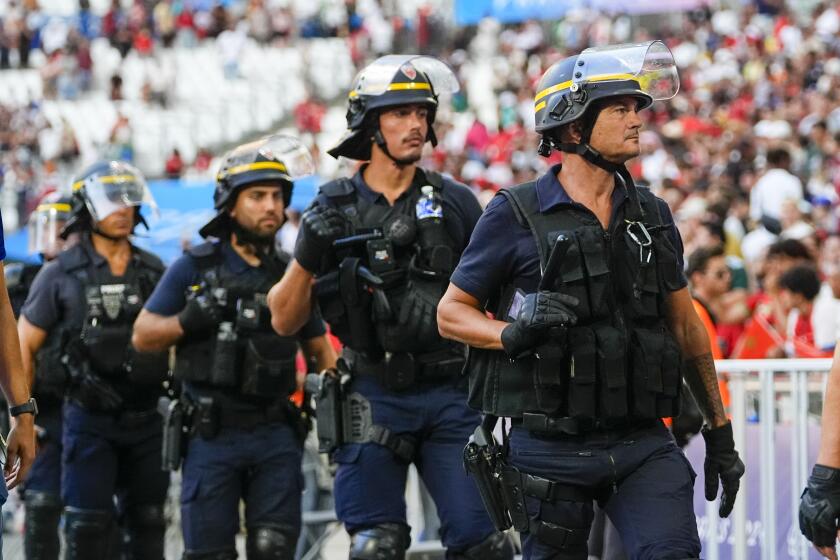Making the soundtrack to Mexico’s drug wars
This country’s rumor mill has been working overtime since Valentin Elizalde, a 27-year-old banda singer-songwriter, was gunned down near the border a week ago. Elizalde, known as “the Golden Rooster,” died with his manager and driver in a shower of automatic weapon fire shortly after he finished performing at a small fair in Reynosa, across the Rio Grande from McAllen, Texas.
His body wasn’t even in the ground before the innuendo started flying across newspapers, televisions and websites. And although many details of his slaying remain murky, the incident has opened a narrow window onto the sub rosa world of narcocorridos, the immensely popular folk ballads that chronicle and celebrate the lives, loves and illicit achievements of Mexico’s powerful drug lords.
That world apparently was known to Elizalde, though how well known is hard to say. He was born in Sonora, the son of a famous musician and a champion of norteno music, the accordion- and 12-string-guitar-based hybrid of polka, waltz and corrido (narrative sung poetry) that has thrived for generations across Mexico.
While corridos have been used to address a wide range of subject matter -- romantic yearnings, revolutionary ideals, farmworker struggles -- one of the most successful subgenres for roughly the last 30 years, particularly in northern Mexico and the southwestern United States, has been narcocorridos. The best of these controversial tunes, such as “Contrabando y Traicion” (Smuggling and Betrayal), written by Angel Gonzalez and turned into a monster hit by the master corridistas Los Tigres del Norte, are classics of sustained mood, wit and narrative concision.
Elizalde had written and performed several of these musical homages, at least one of which was dedicated to Joaquin “El Chapo” Guzman, the on-the-lam leader of the Sinaloa drug cartel, based in the Pacific coast state of that name. Elizalde opened and closed his final, fateful performance with another song, “A Mis Enemigos” (“To My Enemies”), which can be interpreted either as a righteous musical mini-autobiography, a la “My Way,” or an angry taunt.
So far, no evidence has emerged linking Mexico’s drug wars to the death of Elizalde, who left three young daughters. It’s possible that the singer, whose funeral procession drew thousands of mournful fans, was entirely innocent and tragically in the wrong place at the wrong time. But given the ruthlessness that has marked the ongoing turf battle between the Sinaloan and rival Gulf cartel, based in Matamoros and Reynosa, it’s not surprising that Saturday’s triple slaying (a fourth man was badly wounded) is being characterized by many here as a gangland reprisal.
It’s also not surprising that the killers haven’t been identified, even though dozens of people reportedly witnessed the attack. Parts of Mexico today, particularly border areas such as Nuevo Laredo and Tijuana, are virtually paralyzed with tension. Crimes go unreported for fear of retaliation. Regular citizens watch their backs whenever they step outside their homes. Some Mexican newspapers along the frontera have stopped covering the drug wars altogether after their reporters and editors were threatened or killed.
The police, who’ve been as bloodied and intimidated as anyone, have been reluctant to elucidate last Saturday’s massacre. “I don’t want to say. I like my life too much. You should too,” one investigator told the San Antonio Express-News.
Elijah Wald, a Los Angeles-based music journalist and author of the book “Narcocorrido: A Journey Into the Music of Drugs, Guns, and Guerrillas,” cautions against drawing premature conclusions about what befell Elizalde. While “it’s not inconceivable” that the singer was killed by drug cartel assassins, Wald says, “it’s equally possible that he fooled around with the wrong woman.”
“There’s nothing that Mexican corrido fans love like conspiracy theories,” he adds.
Wald points out that over the last 15 or so years there has been only one case of a high-profile corridista being gunned down: Chalino Sanchez. Sanchez had been a marked man: After being shot at during a concert in Coachella in January 1992, he was found dead in May of that year after performing in Culiacan, Sinaloa. The case never has been solved. “I spent quite a lot of time running around Sinaloa asking people about Chalino’s death. Nobody gave you the same answer,” Wald says.
To their admirers, narcocorridos are a vibrant popular art form and a kind of “living newspaper” whose roots reach to medieval Europe. To their critics, the songs are part of an elaborate cultural camouflage that idealizes criminal behavior and exploits the suffering of others. What began as a harmless novelty in the 1970s, they say, has grown uglier, more partisan and more provocative as the drug trade itself has become viciously polarized.
Though evidence is understandably hard to come by, some narcocorridistas allegedly have been paid commissions by drug dealers to write songs lionizing their exploits. Several Mexican states have tried to ban narcocorridos from the airwaves.
But the songs’ continuing popularity testifies to the way that a significant number of mainly poor, working-class Mexicans regard drug traffickers as Robin Hood-style folk heroes, standing up to Mexico’s indifferent ruling elites while defying the notoriously corrupt Mexican police and the hypocritical, drug-bingeing gringos across the border. The melancholic-bravado tone of many of the songs is deeply romantic and redolent of the patriotic ballads of the Mexican Revolution.
The same worshipful, retro-nostalgic attitude toward the outlaw/rebel figure can be found in contemporary gangsta rap, as well as in many traditional U.S. folk ballads about Jesse James, John Hardy and others of their ilk. Just listen to the ornery cheer that goes up in the famous, live Folsom Prison recording when Johnny Cash sings, “I shot a man in Reno just to watch him die.”
While Mexico newspapers have reported that people identifying themselves as members of the Sinaloa and Gulf cartels have posted threats of retaliation against rival singers on YouTube.com in the days since Elizalde was killed, Wald suspects these are posturing music fans rather than actual gang members. “I hope I’m right in saying that I don’t think we’re going to see a spate of killings,” he says.
Many of the genre’s core followers probably don’t know or care much about the music’s darker undertones. They just know it’s great to dance to. But the music no longer can be viewed as a quaint little slice of folklorico. Like the drug industry itself, the narcocorrido biz has gone corporate and high-tech.
Today, narcocorridos form a large, profitable, well-connected industry centered in Los Angeles. Its stars sign with big record labels. Their gigs draw sponsorships from beer manufactures and other major companies. (Earlier this month, Elizalde was named “soloist of the year” at Los Premios de la Radio awards at the Gibson Amphitheater in Hollywood.)
Success can breed caution as well as recklessness. Many recording artists, with their eyes on booming sales figures, carefully tailor their lyrics to make them as broadly accessible as possible, so that any aspiring jefe de jefes might adopt one of their songs as his personal anthem, Wald says. “By and large, the singers are pretty cagey about what their songs are about.... Most of the guys that we’re aware of are recording for major labels based in Los Angeles and have no interest in offending multi-millionaires.”
Still, pressure on the drug industry on both sides of the border continues to grow, particularly since the Sept. 11 attacks prompted a crackdown on illegal trafficking of humans and contraband. In a climate of suspicion, paranoia and escalating violence, the narcocorridistas increasingly may find themselves on “a very slippery slope,” says Carlos Velez-Ibanez, chairman of the Department of Trans-border, Chicana/o and Latina/o Studies at Arizona State University. “I think either they have to fish or cut bait,” Velez-Ibanez says, “and you can’t have it both ways.”
*
More to Read
Sign up for Essential California
The most important California stories and recommendations in your inbox every morning.
You may occasionally receive promotional content from the Los Angeles Times.











